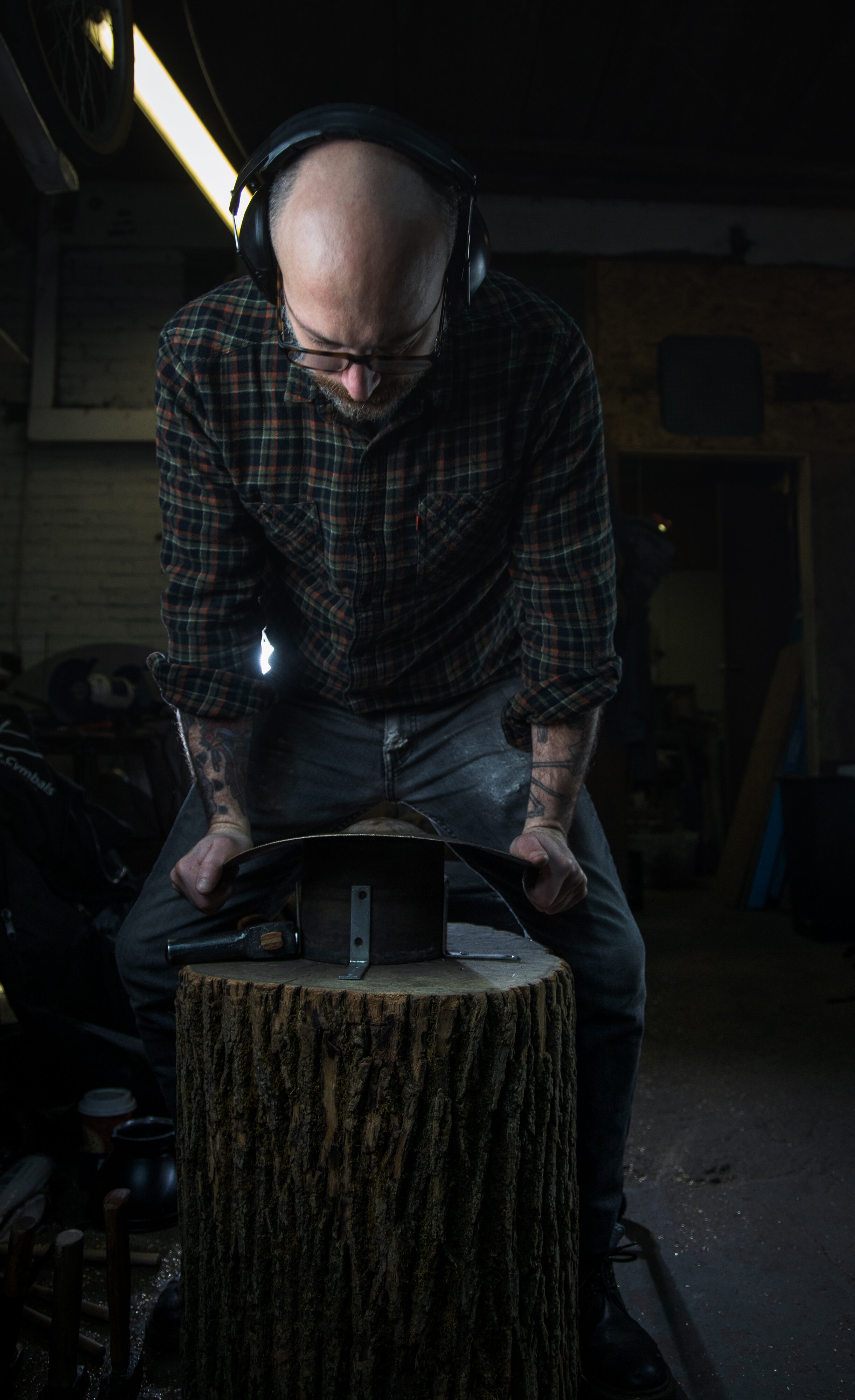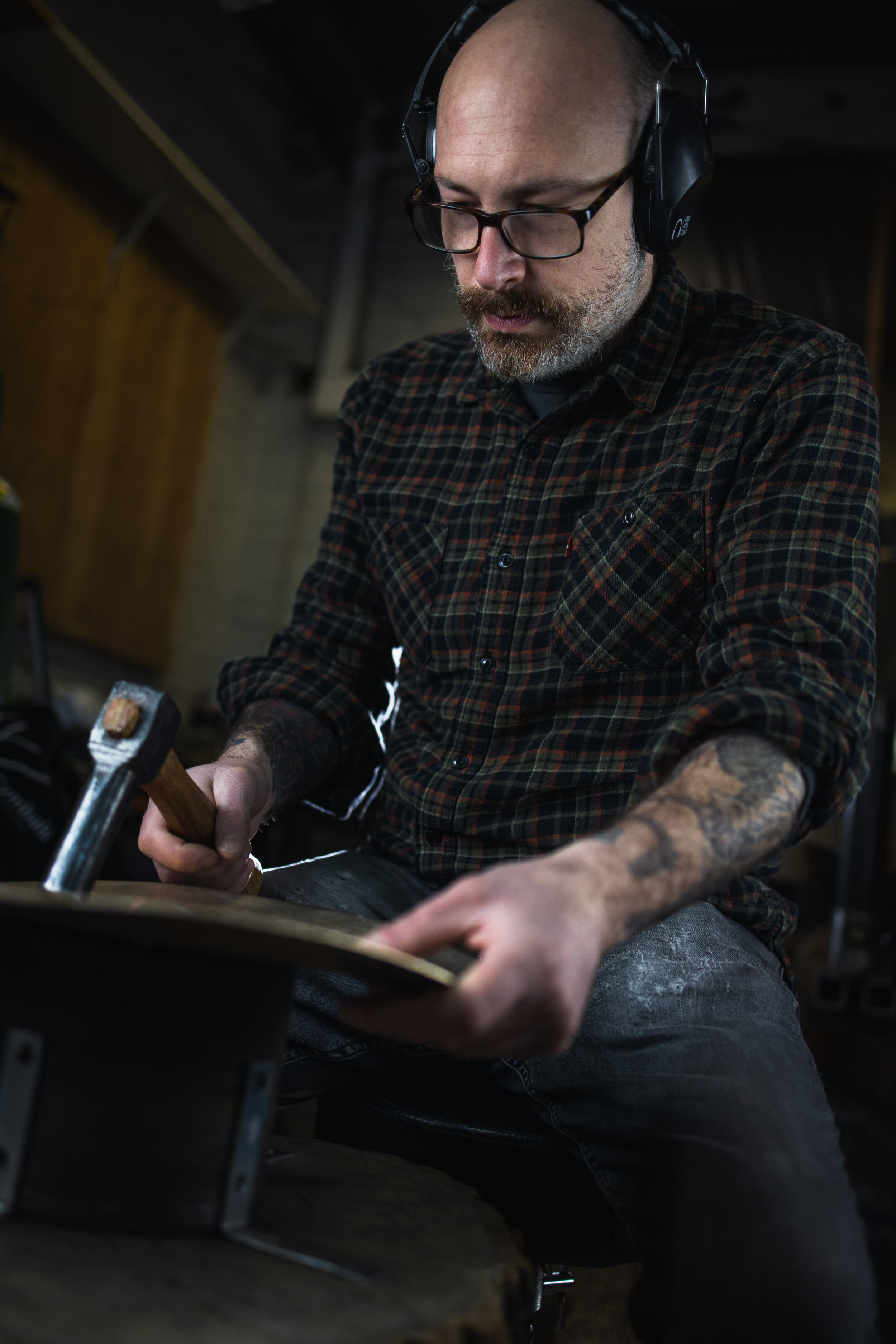Mongiello Cymbals
Sequestered in the back corner of a South Philly garage, surrounded by a fleet of motorcycles, kayaks, and a mountain of bronze shavings, Mike Mongiello of Mongiello Cymbals creates and modifies cymbals for drummers looking for a specific weight to their crashes, more sizzle in the ride, or the right amount of chick to the hi-hats. While Mongiello has found his groove and built a following, the journey to this point wasn’t exactly easy.
Mongiello started his smithing journey 2 years ago after the self-proclaimed gear junkie could not settle on one sound with cymbals available from name brands.
“I’d play something for a little while, trade it in, play something new, that kind of cycle of gear,” Mongiello says. After sampling a wide selection of available cymbals, Mongiello started looking into custom, hand-made gear. “I wanted them to do it for me, I wanted to own them, and then the more I researched about it, the more I wanted to do it myself.”
Cymbal smithing is inherently a secretive craft. “I was on my own at first. It’s pretty secretive and no one will really tell you anything” Mongiello says and goes on to explain, “I don’t think people understand the sheer amount of time it takes to get even a little bit good at this.” Mongiello is referring not only to crafting metal into instruments but also to learning the proper techniques to avoid injury during the process.
Even with the cloud of mystery around the cymbal smithing process, Mongiello was still able to dig up some resources and inspiration, such as Lance Campeau’s Cymbal Project along with the smithing expertise of Roberto Spizzichino and Matt Bettis.
Mongiello’s first cymbal along with his first set of modified hammers. Given the difficulty of sourcing bronze cymbal blanks, Mongiello opted for the much more accessible stainless steel. Steel offered a much cheaper alternative to learn cold forging and metal shaping skills. He was also able to find a niche in the formation of Mongiello Cymbals for drummers looking for a different and unique sound and look to their set of cymbals. The harder composition of steel means that to achieve certain tones the cymbals needed to be much larger than standard cymbals. Reaching up to 36 inches, Mongiello’s stainless steel cymbals made a statement. Ultimately, Mongiello switched to bronze since it’s better suited for cymbal smithing and steel’s fragility was a major drawback.
“No one sells tools. You have to make or modify everything.” Mongiello says. Amongst the challenges of learning a new skill from scratch, there is also the hurdle of acquiring the correct tools. A smithing kit can’t be found at a hardware store, but Mongiello found items to modify for his purposes. Mongiello might use custom-made smithing hammers now, but his first hammers were standard ball peen hammers with half of the head cut off. The anvil used daily was cut from a slab of steel and is fixed to a sturdy stump and a lathe built from scratch.
As Mongiello persisted in his smithing journey, he became accepted into the cymbal smithing community, and veterans of the craft started passing along their wisdom and skills. One of those smithing veterans was Brazilian master cymbal smith Francisco Domene. After discovering Mongiello’s cymbal smithing potential, Domene invited Mongiello to Avaré, Sao Paulo for an introductory course on traditional cymbal making skills. To this day, Mongiello couples these skills with his own developing style for the trademark Mongiello Cymbals sound.
Mongiello’s process starts with a trip to the UPS store. Since it requires an immense amount of energy to smelt and press bronze, Mongiello sources cymbal blanks from a selection of foundries in Turkey. The blanks receive a saltwater bath and sit in the sun before the shaping begins.
Next, the cymbal starts to take shape in the cold forging process. Mongiello pounds and flexes the bronze blank into shape with his specialty hammers. The cold impact forging compresses the bronze with each strike and combined with the continuous shifting of the blank’s position, what was once cymbal shaped piece of metal starts to become an instrument.
“People like to throw around the term hammering pattern,” Mongiello explains with a dismissive shrug between hammering strokes, insinuating that there’s not a defined path to follow, but “there is a form.”
Next, it’s off to the lathe. Since there’s not a specific model of lathe for cymbal smithing, Mongiello had his custom-built. Sharpened carbide bit in hand, Mongiello methodically shaves material from each side of the hammered cymbal. Removing material from the cymbals gives them a lower or darker tone, and increases the wash and sustain for the piece. Depending on the customer’s preference, or the type of cymbal, a target gram weight is essential to reach.
Not every cymbal spends time on the lathe, and for those that make it to the lathe, time is not equally spent. The customer’s preferred cymbal tone determines how much time, if any, each cymbal spends on the lathe. For instance, higher, or brighter, tone cymbals are typically heavier so less bronze needs shaving. Some even just opt for the hammered look without any lathing. Darker, or lower tone cymbals are thinner, so they require more quality time with the carbide bit.
After the main work is completed on each cymbal, they’re finished off with smoothing the edges, and the all-important logo under the cymbal’s bell
After the correct weight and sound tone is achieved on the lathe, depending on the cymbal, it’s either back to hammering, or modifications. Some drummers want a little extra pizzaz with their custom cymbal or when modifying an existing instrument. Rivets, holes, slots, cutting out cracks are all part of Mongiello’s skillset. These modifications add sizzle, cut sustain, or completely change the sound profile of a cymbal to a drummer’s specific taste.
“I just want to put myself into the bronze,” Mongiello says, explaining his long-term goals. As of 2020, Mongiello departed from a long tenure in the restaurant industry to focus fully on his career as a cymbal smith. “I’m not really interested in owning a foundry. I just want to keep getting better.” Making it big isn’t his top priority, but rather just crafting something interesting and giving back to the local music community and beyond.
To view more of Mike Mongiello’s work, visit the Mongiello Cymbals website: www.mongiellocymbals.com















